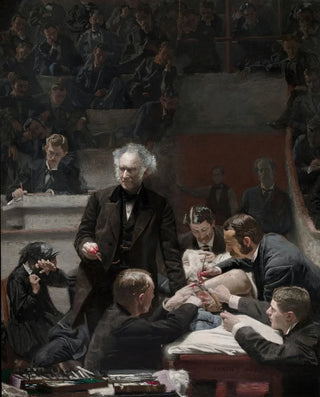Art print | Portrait of Dr. Samuel D. Gross - Thomas Eakins


View from behind

Frame (optional)
Reproduction Portrait of Dr. Samuel D. Gross - Thomas Eakins – Captivating introduction
The "Portrait of Dr. Samuel D. Gross" is an iconic work by American painter Thomas Eakins, created in 1875. This canvas, which captures a surgical scene, transcends a simple portrait to become a true study of the human condition in the face of science and medicine. Eakins, known for his ability to blend realism and emotion, succeeds here in creating a moment that is both intimate and dramatic. The viewer is invited to delve into the medical universe of the 19th century, where the figure of Dr. Gross, a prominent surgeon of the time, is highlighted. This artwork does not merely depict a man but also evokes the ethical and social issues of a period in full transformation.
Style and uniqueness of the work
Eakins' style is characterized by striking realism, mastered technique, and meticulous attention to detail. In this portrait, the composition is carefully orchestrated, featuring Dr. Gross at the center of the scene, surrounded by his students and assistants. The faces of the characters, each with a distinct expression, testify to a moment of tension and concentration, enhancing the emotional impact of the work. The light, illuminating the doctor's face, creates a poignant contrast with the dark background, symbolizing both the clarity of knowledge and the darkness of medical challenges. Eakins also uses earthy colors and rich textures to bring his subjects to life, rendering everything with great veracity. This painting, through its boldness and depth, embodies the very essence of Eakins' art.
The artist and his influence
Thomas Eakins is often regarded as one of the pioneers of American realism. His work extends beyond painting to photography and teaching, influencing an entire generation of artists. Raised in a culture where art was often idealized, Eakins chose to depict the truth, even when it was difficult to face. His frank and direct approach paved the way for later artistic movements, especially those seeking to explore social and psychological themes. The "Portrait of Dr.

Matte finish

View from behind

Frame (optional)
Reproduction Portrait of Dr. Samuel D. Gross - Thomas Eakins – Captivating introduction
The "Portrait of Dr. Samuel D. Gross" is an iconic work by American painter Thomas Eakins, created in 1875. This canvas, which captures a surgical scene, transcends a simple portrait to become a true study of the human condition in the face of science and medicine. Eakins, known for his ability to blend realism and emotion, succeeds here in creating a moment that is both intimate and dramatic. The viewer is invited to delve into the medical universe of the 19th century, where the figure of Dr. Gross, a prominent surgeon of the time, is highlighted. This artwork does not merely depict a man but also evokes the ethical and social issues of a period in full transformation.
Style and uniqueness of the work
Eakins' style is characterized by striking realism, mastered technique, and meticulous attention to detail. In this portrait, the composition is carefully orchestrated, featuring Dr. Gross at the center of the scene, surrounded by his students and assistants. The faces of the characters, each with a distinct expression, testify to a moment of tension and concentration, enhancing the emotional impact of the work. The light, illuminating the doctor's face, creates a poignant contrast with the dark background, symbolizing both the clarity of knowledge and the darkness of medical challenges. Eakins also uses earthy colors and rich textures to bring his subjects to life, rendering everything with great veracity. This painting, through its boldness and depth, embodies the very essence of Eakins' art.
The artist and his influence
Thomas Eakins is often regarded as one of the pioneers of American realism. His work extends beyond painting to photography and teaching, influencing an entire generation of artists. Raised in a culture where art was often idealized, Eakins chose to depict the truth, even when it was difficult to face. His frank and direct approach paved the way for later artistic movements, especially those seeking to explore social and psychological themes. The "Portrait of Dr.






